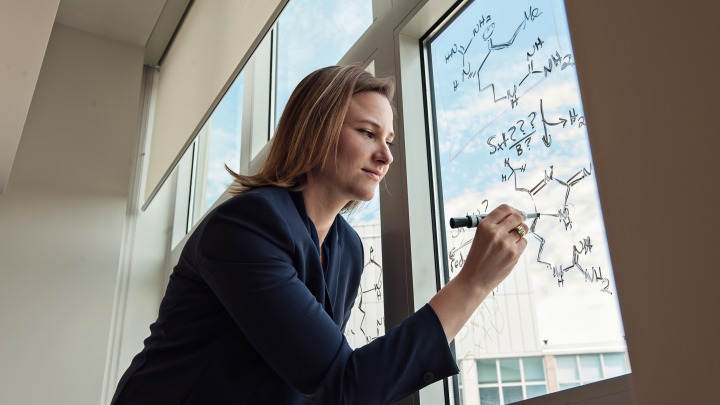
Innovating on all fronts
On February 11, the Research Corporation for Science Advancement announced the 24 recipients of the 2019 Cottrell Scholar Award, chosen for their innovative approaches to integrating science teaching and research.
Eight days later, the Alfred P. Sloan Foundation announced this year’s 126 Sloan Research Fellows, touting them as “the most promising scientific researchers working today.”
Alison Narayan, Ph.D, was one of only two researchers in the country who found their names on both lists.
Taken together, these two awards illustrate Narayan’s passion for advancing bold approaches to synthetic organic chemistry — not only within her lab, but in undergraduate classrooms where she can help shape the next generation of innovative chemists.
‘A vanguard of twenty-first century science’
While announcing this year’s fellows, Alfred P. Sloan Foundation President Adam F. Falkin emphasized that the fellows “stand out for their creativity, for their hard work, for the importance of the issues they tackle, and the energy and innovation with which they tackle them.”
“To be a Sloan Fellow is to be in the vanguard of twenty-first century science,” he noted.
Narayan joined the University of Michigan faculty less than four years ago, as an assistant professor of chemistry in the College of Literature, Science, and the Arts and a faculty member at the Life Sciences Institute, where her lab is located. But she has quickly earned her place on this list of the nation’s most promising young researchers through creative cultivation of two traditionally separate approaches to building molecules.
“We’re focused both on how we can efficiently make molecules with important biological activities, and on how we can use enzymes to do chemistry,” Narayan explains. “And, classically, there has been a gap between these two fields.”
Her research group is now bridging that gap by integrating biocatalysts into synthetic chemistry. Rather than relying on expensive or toxic reagents, her lab uses enzymes that have evolved in nature to perform complex chemical reactions in water, at room temperature.
Narayan’s goal is to develop methods that are not only greener, but also faster. Building the molecules that can become new medicines or other materials often requires many chemical steps. While looking for enzymes that can perform individual steps within this process, researchers in her lab are also looking at the bigger picture.
“Instead of just replacing the chemical step with an enzymatic step, we’re thinking about the types of enzyme-mediated reactions that will totally reroute the entire process,” she says.
By analyzing enzymes for the full range of reactions they can induce — and engineering enzymes to build new variations of molecules — Narayan seeks to make biocatalysis accessible to synthetic chemists across industry and academia.
“It’s green, it’s efficient, and it’s safe,” she says. “This is the future of how people will build molecules.”
‘The very best teacher-scholars’
In the lab, Narayan is focused on developing methods for the future of chemical synthesis; in the classroom, she’s simultaneously developing future chemists who are equipped to perform and build on those methods.
This dual focus led the Research Corporation for Science Advancement to name her as among “the very best early career teacher-scholars in chemistry, physics and astronomy.”
Each fall, approximately 1,600 undergraduates enroll in CHEM 210, U-M’s introductory organic chemistry course. While the university offers a range of resources for these students, Narayan — who leads one of the four sections of nearly 400 students — is pushing new strategies that have the potential to benefit two generations of scientists simultaneously.
The organic chemistry course incorporates graduate student instructors (GSIs), along with the faculty members who lead lectures, to run discussion groups and problem-solving activities. Narayan quickly realized that GSIs were often underprepared to teach the course.
“We teach organic chemistry here in a way that is not taught everywhere,” Narayan explains. “The GSIs are expected to come in and teach something the way we teach it, before they’ve learned it that way. And that’s just setting them up for failure.”
Working with Jessica Yazarians, a graduate student in her lab, Narayan is developing a set of resources that will attack this problem on two fronts. First, they want to provide the GSIs with greater content knowledge of what they need to teach within the context of Chem 210 at U-M.
Narayan also recognizes that most GSIs are first- and second-year graduate students who have not had extensive experience leading classrooms. So she and Yazarians are creating materials to help them hone their teaching skills and to foster a dialog around classroom strategies.
The goal is to make a change that will benefit both undergraduate students and GSIs.
“We are developing the GSIs into a better resource for the students taking the class,” she says. “And then, at the same time, we are investing in the next generation of chemical educators and trying to create a better experience for them.”
The announcement of Narayan’s Cottrell Award in conjunction with her Sloan Fellowship reflects her approach to integrating her research and teaching passions.
“I view my teaching as an extension of my research program,” she says. “Both in my lab, and beginning in intro-level classes, I view synthetic chemistry through the lens of biocatalysis and share this with my students —eventually, we will no longer think of chemical catalysis and as separate from biocatalysis. It is all just catalysis.”


